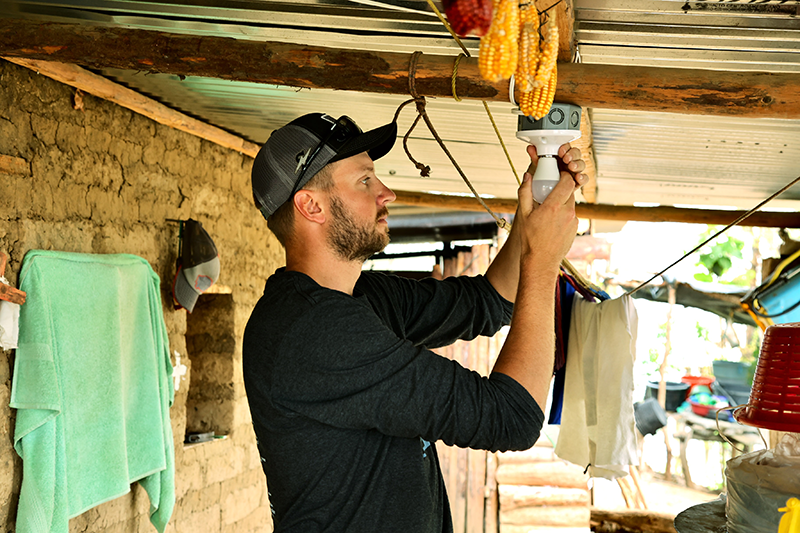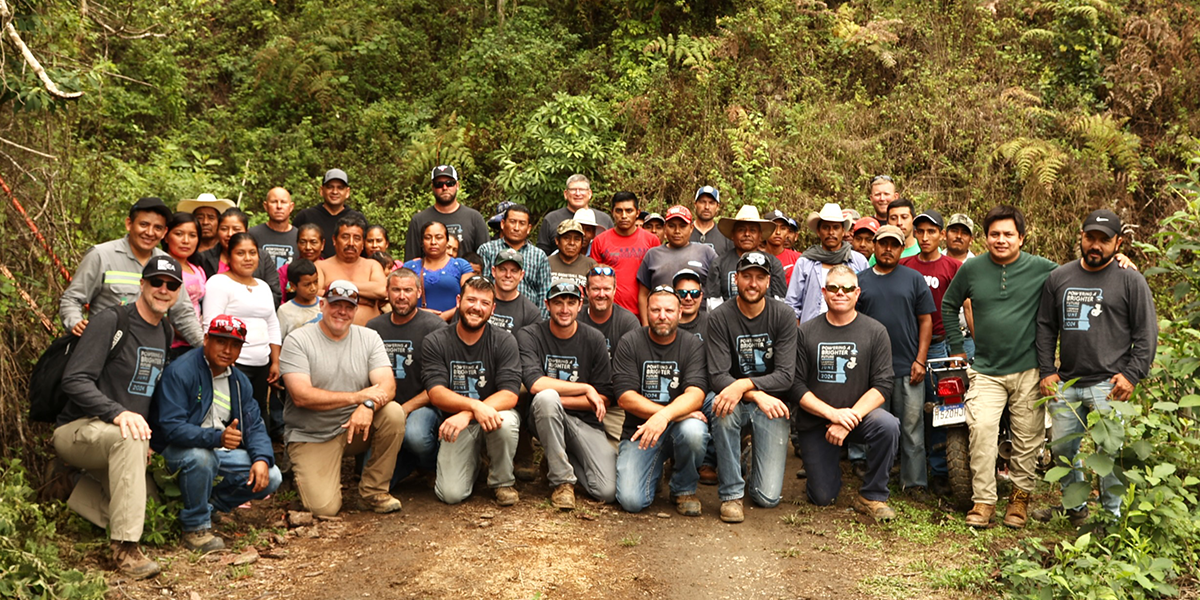Iowa, Minnesota Line Workers Bring Electricity to Guatemala

A team of 14 volunteer line workers from Iowa and Minnesota electric cooperatives helped bring electricity to a small, rural town in southeastern Guatemala last June. Coordinated by the Iowa Association of Electric Cooperatives (IAEC) and the Minnesota Rural Electric Association (MREA), the international mission was IAEC’s second and MREA’s first. CFC and NCSC were proud to support the project with $50,000 in grants.
“Bringing electricity to under-served areas connects electric cooperatives to our roots,” IAEC Director of Communications Erin Campbell said. “None of us were alive in the 1930s and ‘40s when rural electrification first transformed rural America, but we can actively witness that transformation today in other parts of the world that desperately need access to electricity.”
Last-Minute Changes Cause Project Rethink
Planning and preparation for a mission like this starts early, but there was a last-minute snag that caused some challenges.
“A few weeks before the project was supposed to begin in the village of La Hortiga, we learned that the wrong type of distribution poles had been ordered and they were cement poles that our line workers would not be able to climb,” Campbell explained. “At that point we had two options: delay our timeline until the correct poles arrived, or transition to another project in Guatemala and maintain our original dates. The team decided to stick with the original dates and transitioned to a project in the village of Las Peñas.”
The new mission involved completing the build-out of an earlier project begun by crews from Alabama and Tennessee: see “Alabama, Tennessee Co-ops Power Up Guatemalan Village,” Solutions News Bulletin, March 10, 2025.
“The last-minute changes caused some anxiety for the team,” IAEC Director of Safety and Loss Control Scott Meinecke said. “They had not evaluated the job in that village, so it was a leap of faith. But the team rallied, and it actually worked out fine.”
Another challenge the team had to overcome was the rainy weather, which made it difficult for vehicles to get in and out of the village.
“The road into the village was very hard to travel on,” MREA Communications Director Joe Miller said. “And when it rained, it was downright treacherous. Crews often walked in because it was just too dangerous to drive.”
Hunter Venz, a line worker from Prairie Energy Cooperative in Iowa, shared, “When it rains, you can’t get to the village without walking. The road is only built for tractors, horses and mules.”
Meinecke added, “Besides this, everything requires you to go up or down in elevation.
The linemen had to leave the job early enough each day to be able to get back before dark and allow for various contingencies that would come up.”
Local Help Comes Through
Workers from the local municipal electric utility, Empresa Eléctrica Municipal de Jalapa (EEMJ), together with the villagers, had set the poles and anchors before the Iowa and Minnesota crews arrived. They also supported the team during the build-out.
“The villagers were amazing,” Meinecke said. “They had been working to get electricity to their village for 10 years. They would carry our tools and materials from job to job. Many wore soccer cleats for traction.”
The locals were very willing to help. “They ran the wire between the spans,” Miller added. “They had to take the wire and walk or run down the valley and up the other side with the line. They would not let the line workers do that part of the job. They were much more used to traveling up and down the mountains on foot than our guys were.”
 Line workers from Iowa and Minnesota pose with Las Peñas villagers.
Line workers from Iowa and Minnesota pose with Las Peñas villagers.
By the end of the project, the team had installed about 3.5 miles of primary and secondary line and several transformers to serve about 35 homes. Each home had a meter, a 120-volt service panel, two outlets and two lights installed.
The new lines are connected to the EEMJ system, and the municipal utility will provide maintenance going forward.
Electricity Changes Lives
“The villagers were very happy to get electricity. It will change lives,” Miller said.
“Las Peñas had no sustained source of electricity,” Meinecke explained. “They had a few small gas generators and some solar panels. As you walk around the village, there is the smell of burning wood, much like a campground. That was their source of heat to cook. The plight of a young girl is to gather the firewood, grind the corn by hand, help her mother make tortillas and process the food to be eaten on a daily basis. The water system was gravity fed, from a water tank that must be filled regularly. The little girls do not attend school.”
Now, with electricity, the villagers can grind corn with power equipment, taking a fraction of the time. They can cook with electricity, resulting in less smoke in the local environment and healthier living. They can store food in a refrigerator or freezer, preventing rot, decay, food borne illnesses and reheat the food prepared in bulk earlier.
“The children can have a light bulb to allow them to read and study after dark,” Meinecke said. “The water can be pumped to the distribution system. The little girls can now choose to go to school. As a grandfather of five granddaughters, I am so proud to have had a part in this!”
CFC, NCSC Grants Help
“IAEC is very grateful for CFC and NCSC’s generous financial support,” Campbell said. “The grants helped us raise enough funding to make these projects financially feasible for Iowa’s electric cooperatives.”
“MREA is very appreciative of the financial assistance,” Miller added. “All funds collected helped send the crews to Guatemala and paid for materials to do the work. Work like this could not be done without the generous help of partners like CFC and NCSC.”
Both statewides plan to participate in future international electrification projects.
“Our member cooperatives are very supportive of the international program, and MREA is looking to participate again in 2027,” Miller said.
“IAEC has signed up to coordinate our third international project sometime in 2026,” Campbell added. “Many line workers wanted to volunteer in 2019 and 2024, and I suspect there will be even more interest in 2026 as previous volunteers share their experiences with their peers. It truly is a once-in-a-lifetime opportunity to power a brighter future for those less fortunate.”